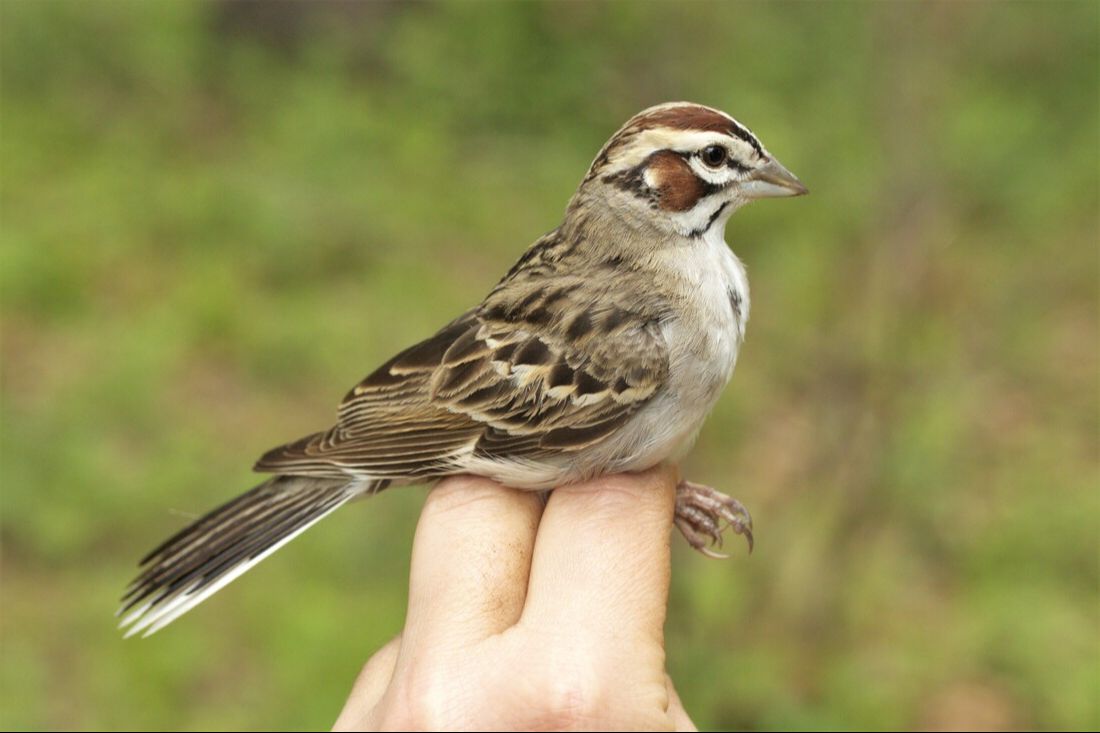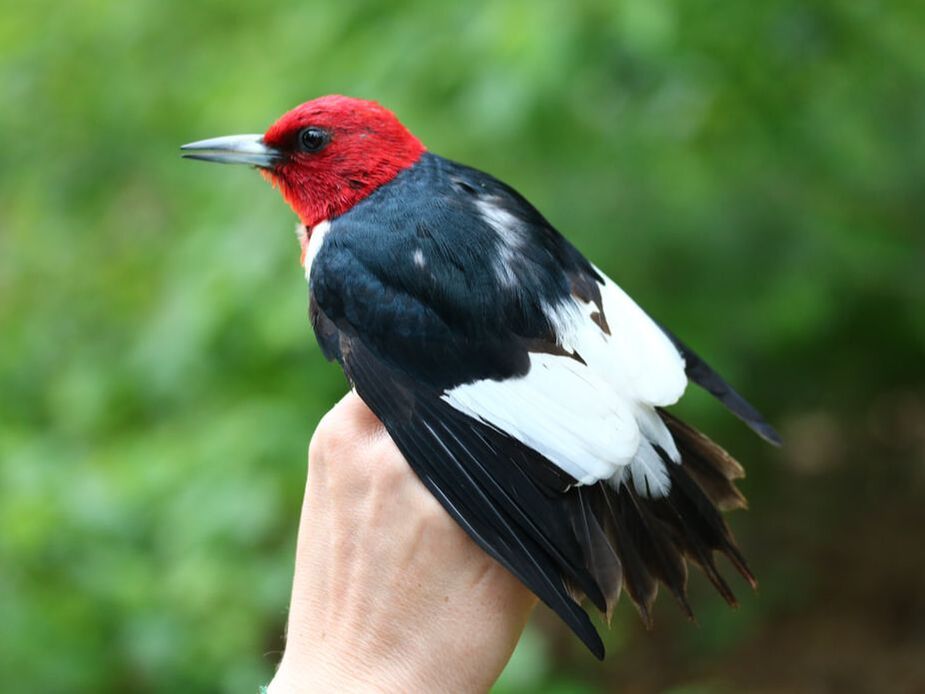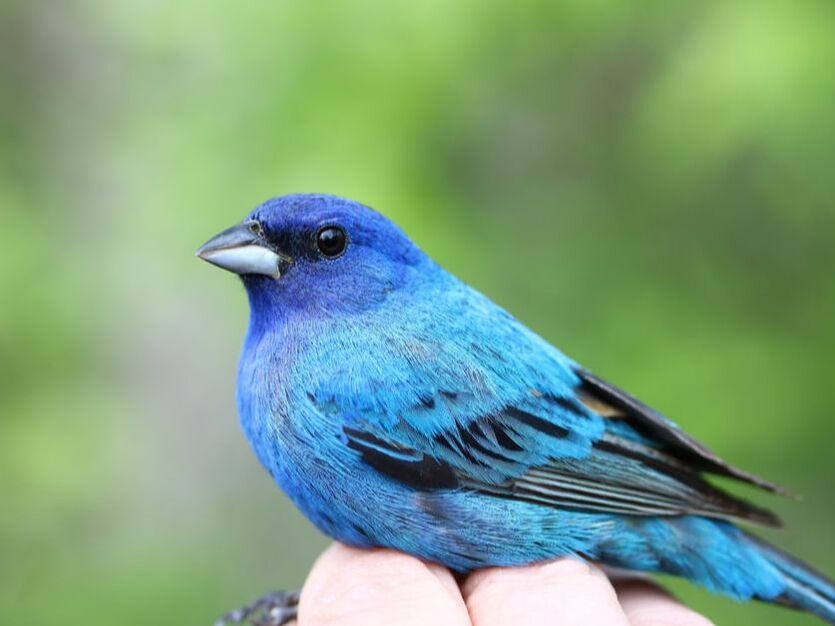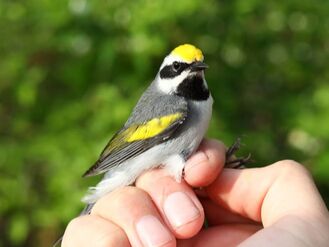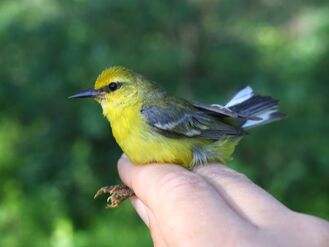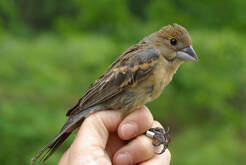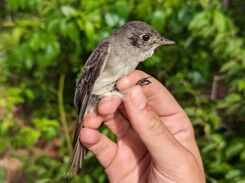AVIAN DIVERSITY IN MANAGED LANDSCAPES
IN THE OAK OPENINGS REGION
The Oak Openings habitat is the sole remaining patch of a once larger biome of the lower Great Lakes system. Prior to European settlement, the Oak Openings was a pocket of prairie and oak savanna nearly surrounded by the forests of the Great Black Swamp.
Four habitats have been investigated at the Oak Openings research site since 1993 as part of ongoing research of the Oak Openings region and in conjunction with the MAPS program. Degraded grassland (shrub/scrub), grassland, managed oak savanna, and unmanaged oak woodland each have four nets placed and monitored once every 10 days from June to early August. Data collected on captured birds includes species, age, sex, fat condition, mass, molt, breeding status, time, and net of capture. Banding effort is conducted for six hours each sample day.
Four habitats have been investigated at the Oak Openings research site since 1993 as part of ongoing research of the Oak Openings region and in conjunction with the MAPS program. Degraded grassland (shrub/scrub), grassland, managed oak savanna, and unmanaged oak woodland each have four nets placed and monitored once every 10 days from June to early August. Data collected on captured birds includes species, age, sex, fat condition, mass, molt, breeding status, time, and net of capture. Banding effort is conducted for six hours each sample day.
Prior to the 1994 breeding season the grassland was cleared of all woody vegetation. It was mowed during the fall of 1995 and burned in the springs of 1996 and 1997 to maintain its openness. The managed oak savanna was burned in the spring of 1994, 1995, 1998, and 1999. The scrub/shrub was partially cleared in 1994, 1999 and 2003.
Species richness and bird abundance was compared between the four habitats. The scrub/shrub habitat indicated the greatest richness and abundance followed by the grassland, unburned oak woodland, and the managed oak savanna with the lowest richness and abundance. Each species was assigned to one of four community categories. These were woodland, grassland, shrub, and generalist. Grassland specialists were captured only in the grassland habitat while generalist made up the greatest component of richness for each habitat. The generalist also made up the greatest proportion of bird abundance for all habitats except the oak woodland which was dominated by woodland specialist.
Management changes conducted in 1994 resulted in considerable avian changes in the studied habitats. The removal of woody vegetation from the grassland habitat resulted in the elimination or reduction of many species more associated with shrub communities. Lark Sparrows responded favorably to defragmentation of the grassland and appeared as a breeding species. Success at nesting has remained more elusive. Clearing within the shrub habitat also reduced the appearance of species more associated with woodlands and heavy shrub habitats.
The Golden-winged Warbler is another species of special interest for the Oak Openings. Recognized by Louis Campbell as the species most indicative of the region, the Golden-winged Warbler has disappeared because of habitat changes and pressure from the closely-related Blue-winged Warbler. Banding operations have identified potential habitat at the Oak Openings research site for the Golden-winged Warbler. Capture and sightings have been associated with the shrub habitat in relationship to oak woodland and wet meadow presence.
Reports on each year's effort and data can be found under Breeding Bird Surveys HERE.
Species richness and bird abundance was compared between the four habitats. The scrub/shrub habitat indicated the greatest richness and abundance followed by the grassland, unburned oak woodland, and the managed oak savanna with the lowest richness and abundance. Each species was assigned to one of four community categories. These were woodland, grassland, shrub, and generalist. Grassland specialists were captured only in the grassland habitat while generalist made up the greatest component of richness for each habitat. The generalist also made up the greatest proportion of bird abundance for all habitats except the oak woodland which was dominated by woodland specialist.
Management changes conducted in 1994 resulted in considerable avian changes in the studied habitats. The removal of woody vegetation from the grassland habitat resulted in the elimination or reduction of many species more associated with shrub communities. Lark Sparrows responded favorably to defragmentation of the grassland and appeared as a breeding species. Success at nesting has remained more elusive. Clearing within the shrub habitat also reduced the appearance of species more associated with woodlands and heavy shrub habitats.
The Golden-winged Warbler is another species of special interest for the Oak Openings. Recognized by Louis Campbell as the species most indicative of the region, the Golden-winged Warbler has disappeared because of habitat changes and pressure from the closely-related Blue-winged Warbler. Banding operations have identified potential habitat at the Oak Openings research site for the Golden-winged Warbler. Capture and sightings have been associated with the shrub habitat in relationship to oak woodland and wet meadow presence.
Reports on each year's effort and data can be found under Breeding Bird Surveys HERE.
Longevity Records
|
Blue Grosbeak number 2281-42527 was banded at the Oak Openings site on 14 June 2008 as a second-year female. She was recaptured on 5 July 2017 at the site, representing an age of 10 years 1 month upon encounter and a new longevity record for the species at the time.
Read the note about this encounter HERE. |
|
Eastern Wood-Pewee number 2260-02862 was banded at the Oak Openings site on 13 June 2014 as an after-hatching-year. The bird was recaptured on 22 June 2023 at the site, representing an age of at least 10 years upon encounter and a new longevity record for the species.
Recaptures within season are generally low for flycatchers and returns between years even less frequent. |
Monitoring Avian Productivity and Survivorship (MAPS)
The long-term monitoring programs for breeding landbirds indicate declining population trends in migrant species in eastern North America. While many trends have been downward, the only long term program providing a measure of productivity and estimates of survival is the Monitoring Avian Productivity and Survivorship (MAPS) program. MAPS objective is to document continental tendencies in productivity and survivorship. The purpose of BSBO’s breeding bird surveys is to not only meet national objectives of MAPS but to address state and/or local questions.
An important part of understanding population trends is determining reproduction success for target species. Utilizing the methodology developed by The Institute of Bird Populations, constant effort mist netting allows for comparison from site to site and year to year. Standardization from year to year and continuation of the study for at least twenty consecutive years at each station are necessary in order to provide reliable estimates of annual variations in productivity and survivorship.
Banding operations are conducted once each ten day period during June through early August. This time frame reduces the confusion with major migration periods, reduces trap biases from net familiarity, and reduces capture interference on breeding success. These long-term projects allow BSBO to investigate habitat changes or succession and their effects on birds, avian community changes, abundance, diversity, and species richness over time in a variety of areas of Ohio.
For more information about MAPS visit the Institute for Bird Populations.
An important part of understanding population trends is determining reproduction success for target species. Utilizing the methodology developed by The Institute of Bird Populations, constant effort mist netting allows for comparison from site to site and year to year. Standardization from year to year and continuation of the study for at least twenty consecutive years at each station are necessary in order to provide reliable estimates of annual variations in productivity and survivorship.
Banding operations are conducted once each ten day period during June through early August. This time frame reduces the confusion with major migration periods, reduces trap biases from net familiarity, and reduces capture interference on breeding success. These long-term projects allow BSBO to investigate habitat changes or succession and their effects on birds, avian community changes, abundance, diversity, and species richness over time in a variety of areas of Ohio.
For more information about MAPS visit the Institute for Bird Populations.
